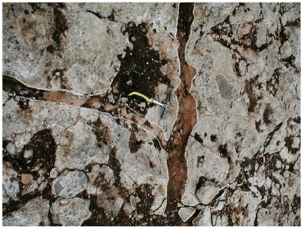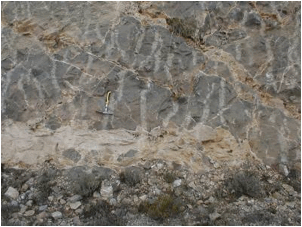Breccia dikes in the Rubielos de la Cérida impact basin
Breccia dikes are prominent features in impact structures. Most researchers assume that they form primarily in the excavation stage of impact cratering by the injection of material into the floor and the walls of the growing and changing excavation cavity. Dikes may also form in the modification stage of impact cratering. Like the Azuara structure (see https://www.impact-structures.com/spain/ ), the Rubielos de la Cérida basin presents a large variety of impact breccia dikes cutting through rocks of very different lithologies (carbonate rocks, silicate rocks, conglomerates, polymictic breccias).
Regional geologists from Spain (M. Aurell, E. Díaz-Martínez, A. L. Cortés, and others) categorically refusing the impact origin of Azuara and Rubielos de la Cérida, suggest the breccia dikes to be mostly related with karstification and other non-impact processes. We point to the fact that karstification requires carbonate (or sulfate) dissolution, but the dikes presented below do not show any dissolution features. Of course, karst features do exist in the impact region, but an experienced geologist will hardly confuse both. For comparison, we show further down a typical karst crevice exposed near an impact breccia dike. In a few cases, we observe features in breccia dikes known also from karstic areas, such as calcite crusts. This is not surprising, because carbonate dissolution and precipitation could well be related with post-impact groundwater migration, not to forget significant post-impact hydrothermal activity typical of large impacts.

 Fig. 1. Polymictic breccia dike cutting through Muschelkalk limestones. Northern rim region of the Rubielos de la Cérida impact basin; near Olalla.
Fig. 1. Polymictic breccia dike cutting through Muschelkalk limestones. Northern rim region of the Rubielos de la Cérida impact basin; near Olalla.

 Fig. 2. Breccia dikes cutting through strongly shattered Paleozoic silicate rocks. Northern rim region of the Rubielos de la Cérida impact basin; near Olalla.
Fig. 2. Breccia dikes cutting through strongly shattered Paleozoic silicate rocks. Northern rim region of the Rubielos de la Cérida impact basin; near Olalla.

 Fig. 3. Breccia dike cutting sharply through Malmian limestones. Note the ribbon texture pointing to chemical interaction between dike material and the host rock. Northeast basin, between Corbatón and Bañon.
Fig. 3. Breccia dike cutting sharply through Malmian limestones. Note the ribbon texture pointing to chemical interaction between dike material and the host rock. Northeast basin, between Corbatón and Bañon.
 Figs. 4, 5. For comparison: karst in the Rubielos de la Cérida impact basin, between Corbatón and Bañon, exposed about 50 m from the impact breccia dike shown in Fig. 3.
Figs. 4, 5. For comparison: karst in the Rubielos de la Cérida impact basin, between Corbatón and Bañon, exposed about 50 m from the impact breccia dike shown in Fig. 3.
 Fig. 5. Detail of the karst feature in Fig. 4. Note the well-rounded clasts resulting from carbonate dissolution. The sharp-edged fragments have been produced by the excavator while performing the new road cut.
Fig. 5. Detail of the karst feature in Fig. 4. Note the well-rounded clasts resulting from carbonate dissolution. The sharp-edged fragments have been produced by the excavator while performing the new road cut.
 Figs. 6, 7. Breccia dikes in Jurassic limestones. Central-uplift chain, Sierra de Palomera.
Figs. 6, 7. Breccia dikes in Jurassic limestones. Central-uplift chain, Sierra de Palomera.
 ….
….  Fig. 7. Detail of the dike system in Fig. 6.
Fig. 7. Detail of the dike system in Fig. 6.
 ….
….  Fig. 8. Breccia dikes cutting through conglomerates. Eastern basin, between Alfambra and Escorihuela.
Fig. 8. Breccia dikes cutting through conglomerates. Eastern basin, between Alfambra and Escorihuela.
 ….
….  Fig. 9. Massive monomictic breccia dike in Muschelkalk limestones. Western basin rim near Santa Eulalia.
Fig. 9. Massive monomictic breccia dike in Muschelkalk limestones. Western basin rim near Santa Eulalia.
 ….
….  Fig. 10. Dike cutting sharply through fractured, steeply dipping Jurassic limestones. The white, highly porous matrix material is assumed to be former carbonate melt. Near Ojos Negros.
Fig. 10. Dike cutting sharply through fractured, steeply dipping Jurassic limestones. The white, highly porous matrix material is assumed to be former carbonate melt. Near Ojos Negros.
 ….
….  Fig. 11. Breccia dikes cutting through polymictic basal breccia. Southern central-uplift chain, northeast of Caudé.
Fig. 11. Breccia dikes cutting through polymictic basal breccia. Southern central-uplift chain, northeast of Caudé.
 ….
….  Fig. 12. Breccia dike sharply cutting through Jurassic limestones. The white matrix is assumed to be former carbonate melt. Corbalán quarry.
Fig. 12. Breccia dike sharply cutting through Jurassic limestones. The white matrix is assumed to be former carbonate melt. Corbalán quarry.
 ….
….  Fig. 13. System of breccia dikes in heavily fractured Mesozoic limestones. Southeastern rim region, between Corbalán and Teruel.
Fig. 13. System of breccia dikes in heavily fractured Mesozoic limestones. Southeastern rim region, between Corbalán and Teruel.
 ….
…. Figs. 14-19. Ensemble of various breccia dikes cutting through ?Keuper limestones. Southern rim region, between Valdecebro and Teruel. Note the (penciled) principal dike merging into a large breccia pocket. The excavator scratches must not confuse.
Figs. 14-19. Ensemble of various breccia dikes cutting through ?Keuper limestones. Southern rim region, between Valdecebro and Teruel. Note the (penciled) principal dike merging into a large breccia pocket. The excavator scratches must not confuse.

 Fig. 15. Details of the breccia dike system in Fig. 14.
Fig. 15. Details of the breccia dike system in Fig. 14.
 Fig. 16. Sawed surface of the polymictic dike breccia.
Fig. 16. Sawed surface of the polymictic dike breccia.
 Fig. 17. System of breccia dikelets in the outcrop shown in Fig. 14.
Fig. 17. System of breccia dikelets in the outcrop shown in Fig. 14.
 Fig. 18. On more breccia dike razor-sharply cutting through the host rock. Outcrop seen in Fig. 14.
Fig. 18. On more breccia dike razor-sharply cutting through the host rock. Outcrop seen in Fig. 14.






































































